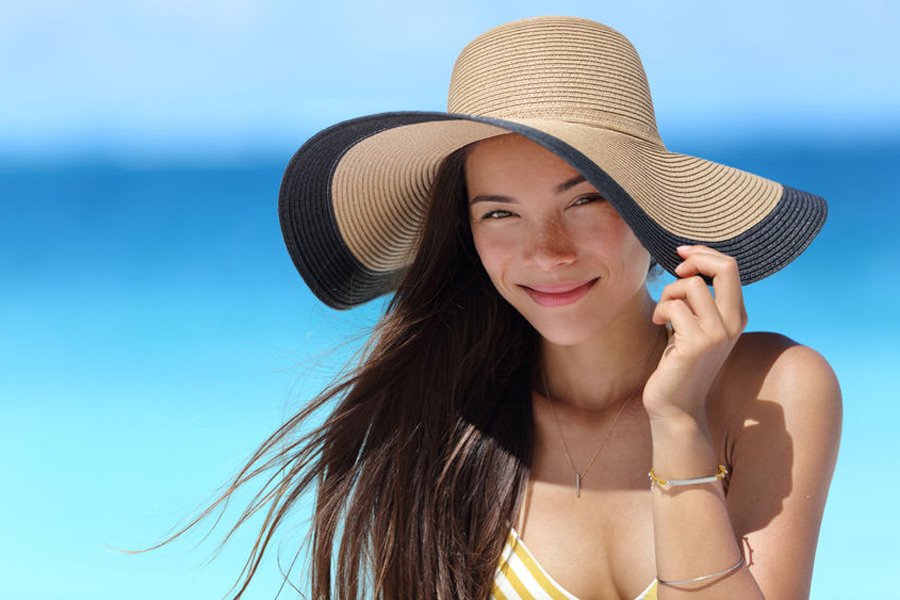I’m often asked about the most common factors contributing to the aging process. Everyday exposure to the sun, pollution, and other factors in our environment contribute to the natural aging process. As residents of the Bay Area, we are fortunate to live in a very mild climate with lots of sunny days. However, this fortune comes at a price, as the sun is the number one enemy we battle in our quest to retain our youthful appearance.
Frequency and intensity of sun exposure accelerates the aging process, damages skin and increases the incidence of skin cancer. As such, part of any healthy lifestyle includes practicing sun safety. We start our lives with thin delicate baby skin and end up with thin delicate elder skin. The care we take to protect our skin really does make a difference. Wearing hats, sunglasses, protective clothing, and liberal use of sunscreen are necessary precautions to protect us from our infancy to our golden years.
This summer, I have noticed children at the pool and playground becoming red and sunburned. Just one bad sunburn in childhood increases our lifetime risk of melanoma (the most fatal form of skin cancer). We need to take effective precautions to reduce these risks. While it is true that over-exposure to the sun may result in more sunspots and premature or excessive wrinkles, melanoma is a very serious consequence of enjoying too much sun throughout our lifespan. Recently, I removed over 50 skin lesions from a 70 year-old patient. Sadly, most of these lesions could have been avoided with a better understanding of how the sun damages the skin and knowledge of the best practices to protect it.
The sun emits two types of ultraviolet rays – UVA and UVB. Either can cause sunburn and damage skin. It is a common misconception that cloudy days offer protection from sunburn. UVA and UVB rays penetrate clouds and still result in sunburn and damaged skin. Medications can also increase the risk of sunburn. These medications include: many antibiotics, most acne medications, and some antidepressants. It is always wise to review your medications with your doctor or pharmacist regarding sun sensitivity.
The best way to enjoy the sunshine is to limit exposure when the sun rays are most intense (between 10 am and 4 pm) and to use adequate sunscreen protection at all times. While the use of sunscreen is critical, it must be used properly in order to be effective. Follow these simple and effective guidelines for sunscreen use:
Sunscreens with a zinc base and broad spectrum coverage are optimal, and zinc is found in higher end brands (we offer Skinmedica, Skinceuticals, Obagi, and Image in our office).
While these brands are some of the most effective available, even the cheapest generic sunscreen is better than wearing nothing at all.
Do not wait until you are in the sun to apply. Sunscreens are designed to be absorbed into the skin. Apply liberally (two ounces, equivalent to a full shot glass, for arms and legs) 30 minutes before sun exposure. It should be reapplied after swimming or excessive sweating.
Regular use of sunscreen can begin at 6 months of age and used indefinitely.
SPF means “sun protection factor”. SPF of 4 provides protection allowing 4 times the sun exposure before burning. SPF 8 equals eight times and so on. SPF 15 blocks 93% of incoming UVB rays, SPF 30 blocks 97%, SPF 50 blocks 98%, and SPF 100 blocks 99% of UVB rays.
One year of sun protection yields noticeably improved skin and reduced risk. It is never too early or too late to start using sunscreen, so start applying it now.
Yearly skin checks with your GP, dermatologist or plastic surgeon will help detect skin cancer early.
These recommendations are meant to be guidelines and need to be tailored to individual skin types. If sunburn does occur, use of cold compresses, over the counter Benadryl, and pain medication may help with the sting. In cases of longer-term sun damage or skin cancer, your dermatologist and your plastic surgeon can help. As always, I welcome the opportunity to help you explore the options available. I wish you a sun safe and happy summer season!


Leave a Reply